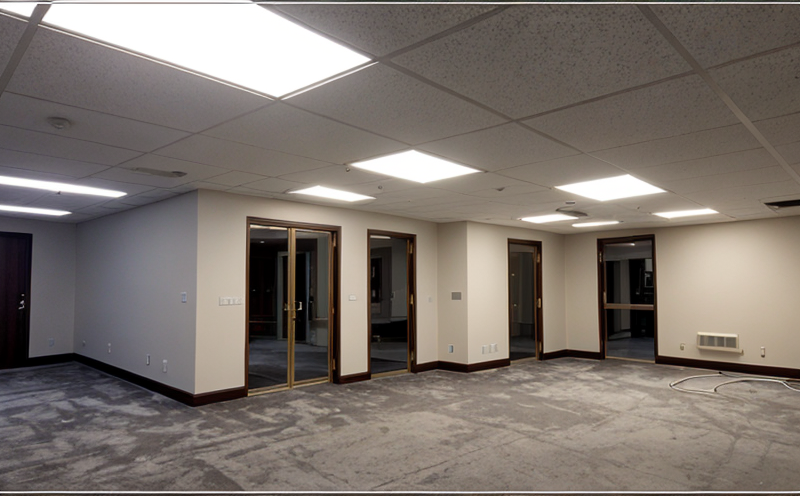UL 1993 Decorative Lighting Safety Testing of Self Ballasted Lamps
The UL 1993 standard is a critical component in ensuring that decorative lighting fixtures and self-ballasted lamps meet stringent safety requirements. This standard applies to decorative lighting products that incorporate self-ballasted lamps, including those used for general illumination, holiday decorations, and other similar applications. The primary objective of this test is to verify the electrical safety and thermal stability of these lamps during both normal use and potential fault conditions.
Self-ballasted lamps are characterized by their integrated ballast, which provides the necessary power supply and current control without an external transformer or choke. This feature makes them highly efficient and popular among manufacturers due to their compact design and ease of installation. However, the integration also means that any defect in the internal circuitry could lead to hazardous conditions if not properly evaluated.
The UL 1993 test addresses several key aspects:
- Electrical insulation integrity
- Overcurrent protection performance
- Thermal stability under various operating conditions
- Impact resistance against mechanical stress
- Flame retardancy and fire safety
- Light output consistency over time
These tests are performed using state-of-the-art equipment such as high-voltage testers, thermal imaging cameras, and specialized impact test machines. The process involves subjecting the lamps to a series of controlled environmental stressors to simulate real-world conditions they might encounter during use.
The testing procedure typically begins with a thorough examination of the lamp’s design and materials to ensure compliance with relevant standards. Following this initial review, the lamp undergoes a series of tests designed to evaluate its performance in different scenarios:
- Overcurrent Testing: The lamp is subjected to an overcurrent condition to assess whether it can withstand excess current without failing or causing a fire.
- Thermal Cycling: This test simulates the cyclical heating and cooling that lamps experience during use, ensuring they remain stable and safe throughout their operational life.
- Impact Testing: The lamp is exposed to mechanical shocks to determine its resilience against accidental impacts or drops. This helps in assessing whether it can withstand typical handling conditions without compromising safety.
- Flame Retardancy Tests: These tests evaluate the lamp’s ability to suppress flames under specified conditions, ensuring that any potential fire hazard is minimized.
The results of these tests are meticulously recorded and analyzed. Compliance with all specified parameters indicates a safe and reliable product. Non-compliance may result in modifications or retesting until all requirements are met.
Understanding the implications of non-compliance is crucial for manufacturers and distributors. Failure to meet UL 1993 standards can lead to recalls, legal issues, and damage to brand reputation. Therefore, adhering to these stringent safety protocols not only ensures consumer protection but also fosters trust in the market.
For those involved in quality management, compliance officers, R&D engineers, and procurement teams, ensuring that products meet UL 1993 standards is paramount. It guarantees that every decorative lighting product on the market is safe for end-users while maintaining high standards of performance and durability.
Benefits
- Increased Consumer Confidence: Compliance with UL 1993 enhances consumer trust by ensuring the safety of decorative lighting products.
- Market Differentiation: Meeting these stringent standards can set your product apart in a competitive market, improving brand reputation and sales.
- Legal Protection: Adhering to UL 1993 minimizes the risk of legal action due to product recalls or accidents involving your lamps.
- Enhanced Product Quality: The rigorous testing process ensures that only high-quality products reach the market, leading to consistent performance and reliability.
The benefits extend beyond compliance; they also contribute to a safer environment for end-users. By choosing UL 1993 Decorative Lighting Safety Testing of Self Ballasted Lamps, you not only meet regulatory requirements but also demonstrate a commitment to excellence in product design and safety.
Why Choose This Test
Selecting the UL 1993 Decorative Lighting Safety Testing of Self Ballasted Lamps is advantageous for several reasons. Firstly, it ensures that your products meet international standards, which are recognized globally. Secondly, this testing helps identify and rectify potential issues early in the development process, saving time and resources in the long run.
Moreover, compliance with UL 1993 demonstrates a commitment to quality and safety, which is increasingly important for consumers today. In an era where safety concerns are paramount, having a tested product can significantly boost your brand’s credibility and market position.
The testing process also provides valuable insights into the performance of your lamps under various conditions. This data can be used to refine designs and improve future iterations of your products, leading to innovations that not only meet but exceed industry expectations.
Finally, by choosing this test, you ensure that your decorative lighting fixtures are safe for use in homes, offices, and public spaces. This commitment to safety is a key factor in maintaining consumer trust and loyalty.
Quality and Reliability Assurance
The UL 1993 Decorative Lighting Safety Testing of Self Ballasted Lamps plays a pivotal role in ensuring the quality and reliability of decorative lighting products. By adhering to this standard, manufacturers can guarantee that their lamps are safe for use under diverse conditions.
Quality assurance through UL 1993 involves several key steps:
- Initial Design Review: The product’s design is thoroughly examined to ensure it meets all relevant safety criteria.
- Component Selection: Only high-quality components are selected for their durability and performance.
- Manufacturing Process Monitoring: The manufacturing process is continuously monitored to maintain consistent quality standards.
- Final Testing and Inspection: Each lamp undergoes rigorous testing before being approved for sale.
This comprehensive approach ensures that every decorative lighting product meets the highest standards of safety, performance, and reliability. It also provides customers with peace of mind, knowing that they are using products that have been thoroughly tested and vetted by a trusted organization like UL.
By implementing these quality assurance measures, manufacturers can build a strong reputation for producing safe and reliable decorative lighting fixtures. This not only enhances customer satisfaction but also contributes to the overall success of their business.





